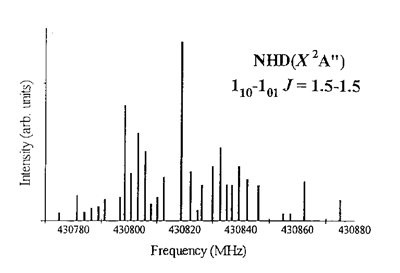
Kaori KOBAYASHI, Hiroyuki OZEKI, Shuji SAITO, Mizuho TONOOKA (Nagoya Univ.) and Satoshi YAMAMOTO (Univ. Tokyo)
[J. Chem. Phys. 107, December 8 issue (1997)]
Monodeuterated species of the NH2 radical has three nonzero spin nuclei and shows an extremely complex hyperfine pattern for each rotational transition, and which has not yet been subjected to microwave spectroscopic study. However, the recent detection of NH2 toward our Galactic Center and a new finding of highly fractionated deuterium species of several interstellar molecules in the hot regions of the Orion KL source has urged us to study this NHD species in the laboratory. We measured the rotational spectral lines of NHD in the millimeter- and submillimeter-wave region. The NHD radical was produced by a dc-glow discharge through a NH3 and D2 mixture at around 220 K. Ten rotational transitions obeying b- and a-type selection rules were observed in the 177-517 GHz region, of which the most important rotational transitions for astronomical observations, 101-000 and 110-101, were included and their detailed fine and hyperfine components were measured with high precision (see Figure 1). The hyperfine interaction of the nitrogen, hydrogen, and deuterium nuclei, which are similar in magnitude, caused complicated hyperfine patterns and made their assignment comparatively difficult. A least-squares analysis of the measured frequencies resulted in the determination of 40 molecular constants including spin-rotation coupling constants of N, H, D and, furthermore, non axial components of magnetic dipolar terms of H and D. The necessity of a higher K-dependent term of the dipole-dipole interaction constant for the hydrogen nucleus relative to the principal axis system reflects the effective geometrical change of the rotational levels.

Figure 1. A stick diagram of the 110-101, J=3/2-3/2 transition of NHD(X2A") in the 430 GHz region with observed relative intensities.